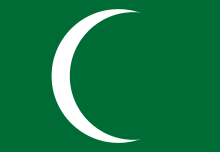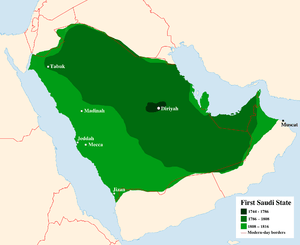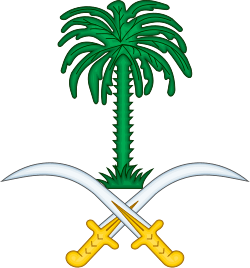Emirate of Diriyah
| Emirate of Diriyah First Saudi State إمارة الدرعية ‘Imāra ad-Dir‘iyya | |||||||||||||
|---|---|---|---|---|---|---|---|---|---|---|---|---|---|
| 1744–1818 | |||||||||||||
 Flag of Diriyah | |||||||||||||
 | |||||||||||||
| Capital | Diriyah | ||||||||||||
| Common languages | Arabic | ||||||||||||
| Religion | (Wahhabi) | ||||||||||||
| Government | Monarchy | ||||||||||||
| Imam | |||||||||||||
• 1744–1765 | Muhammad bin Saud | ||||||||||||
• 1765–1803 | Abdul-Aziz bin Muhammad | ||||||||||||
• 1803–1814 | Saud bin Abdul-Aziz bin Muhammad bin Saud | ||||||||||||
• 1814–1818 | Abdullah bin Saud | ||||||||||||
| History | |||||||||||||
| 1744 | |||||||||||||
| 1818 | |||||||||||||
| |||||||||||||
| Today part of |
| ||||||||||||
Part of a series on the |
|---|
| History of Saudi Arabia |
 |
|
|
The Emirate of Diriyah was the first Saudi state.[1] It was established in the year 1744 (1157 A.H.) when Muhammad ibn Abd al-Wahhab and Prince Muhammad bin Saud formed an alliance to found a socio-religious reform movement to unify the many states of the Arabian Peninsula and free it from Ottoman rule.[2][3] In 1744, both Muhammed bin Abd Al Wahhab and Muhammad bin Saud took an oath to achieve their goal.[4] Marriage between Muhammad bin Saud's son, Abdul-Aziz bin Muhammad, and the daughter of the Muhammad ibn Abd al-Wahhab helped to seal the pact between their families which has lasted through the centuries to the present day.
Early establishment
The House of Saud and its allies quickly rose to become the dominant sovereignty in Arabia by first conquering Najd, and then expanding their influence over the eastern coast which measures from Kuwait down to the northern borders of Oman. Furthermore, Saud's forces brought the highlands of 'Asir under their suzerainty, while Muhammad bin Abd Al Wahhab wrote letters to people and scholars to enter the field of jihad. After many military campaigns, Muhammad bin Saud died in 1765, leaving the leadership to his son, Abdul-Aziz bin Muhammad. Saud's forces went so far as to gain command of the Shi'a holy city of Karbala in 1801. Here they destroyed grave markers of saints and monuments and killed over 5000 civilians.[5] Muhammad bin Abd Al Wahhab died in 1792. In 1803, eleven years after Wahhab's death, the son of Abdul Aziz Bin Muhammad, Saud bin Abdul-Aziz bin Muhammad bin Saud, sent out forces to bring the region of Hejaz under his rule.[6] Ta'if was the first city to be captured, and later the two holy cities of Mecca and Medina. This was seen as a major challenge to the authority of the Ottoman Empire, which had exercised its rule over the holy cities since 1517.
Decline of sovereignty
The task of weakening the grip of the House of Saud was given to the powerful viceroy of Egypt, Muhammad Ali Pasha, by the Ottomans. This initiated the Ottoman–Saudi War, in which Muhammad Ali sent his troops to the Hejaz region by sea. His son, Ibrahim Pasha, then led Ottoman forces into the heart of Nejd, capturing town after town. Saud's successor, his son Abdullah bin Saud, was unable to prevent the recapture of the region.[7] Finally, Ibrahim reached the Saudi capital at Diriyah and placed it under siege for several months until it surrendered in the winter of 1818. Ibrahim then shipped off many members of the clans of Al Saud and Muhammed Ibn Abd Al Wahhab to Egypt and the Ottoman capital, Constantinople. Abdullah bin Saud was later executed in the Ottoman capital Constantinople with his severed head later thrown into the waters of the Bosphorus, marking the end of what was known as the First Saudi State.[8] However, both the Wahhabi sect and the remaining members of the Al Saud clan stayed committed to found a Second Saudi State that lasted until 1891, and later a third state, Saudi Arabia, which continues to rule till the present day.[9]
Rulers of the first Saudi state
- Muhammad bin Saud 1726–1744 (Emir of Diriyah), 1744–1765 (Emir of Nejd)
- Abdul-Aziz bin Muhammad 1765–1803 (1179–1218 H)
- Saud bin Abdul-Aziz bin Muhammad bin Saud (Saud Al Kabeer) 1803–1814 (1218–1233 H)
- Abdullah bin Saud 1814–1818.
See also
References
- ↑ Sir James Norman Dalrymple Anderson. The Kingdom of Saudi Arabia. Stacey International, 1983. Pp. 77.
- ↑ "Reform Movements" (PDF). http://shodhganga.inflibnet.ac.in. Retrieved 17 October 2017. External link in
|website=(help) - ↑ "Muslim Religious Movements". Banglapedia. Retrieved 17 October 2017.
- ↑ al-Rasheed, Madawi (2010). A History of Saudi Arabia. ISBN 978-0-521-74754-7.
- ↑ electricpulp.com. "KARBALA – Encyclopaedia Iranica". www.iranicaonline.org. Retrieved 14 November 2017.
- ↑ Sauds's campaign for Hejaz and the two holy cities Archived 2010-09-14 at the Wayback Machine., Islam Life online magazine
- ↑ Abdullah bin Saud's capture Archived 2010-01-06 at the Wayback Machine., King Abdullah Ibn Saud Information Resource
- ↑ Abdullah bin Saud's execution Archived 2010-01-06 at the Wayback Machine., King Abdullah Ibn Saud Information Resource
- ↑ House of Saud Revivals Archived 2010-01-07 at the Wayback Machine., King Abdullah Ibn Saud Information Resource
Further reading
- Facey, William; Hawkins, Philip (10 March 1997). Dirʻīyyah and the first Saudi state. Stacey International. ISBN 978-0-905743-80-6. Retrieved 26 December 2011.
